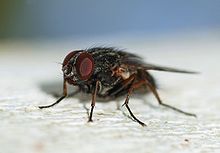Muscina sp.
| Muscina | |
|---|---|
 |
|
| Adult Muscina stabulans | |
| Scientific classification | |
| Kingdom: | Animalia |
| Phylum: | Arthropoda |
| Class: | Insecta |
| Order: | Diptera |
| Family: | Muscidae |
| Subfamily: | Azeliinae |
| Tribe: | Reinwardtiini |
| Genus: |
Muscina Robineau-Desvoidy, 1830 |
| Type species | |
|
M. stabulans Fallén, 1817 |
|
Muscina is a genus of flies that belongs to the family Muscidae, currently consisting of 27 species. They are worldwide in distribution and are frequently found in livestock facilities and outside restrooms. The most common species are M. stabulans (the most widely studied species), M. levida, and M. prolapsa. Muscina flies commonly breed in manure and defecate on food, which has been linked to the spread of some disease and illnesses. The occurrence of Muscina larvae on dead bodies has led to their regular use in forensic investigations, as they may be used to estimate the time of death. Research have shown the prevalence of certain species of Muscina flies as vectors of diseases such as poliomyelitis.
Muscina species are characterized by a retractable proboscis, sponging or sucking mouthparts, and a pale tip on the scutellum. The species M. stabulans and M. levida are larger than the housefly, and have moderately curved fourth veins with the latter also having a black palpi. The species M. levida has legs that are entirely black. M. pascuorum flies have a red palpi, a strongly curved fourth vein that ends in or before the wing tip, and are generally larger than M. levida.
The species M. stabulans, more commonly known as the false stable fly, has partially reddish-brown legs, four characteristic dark stripes along the thorax region, and a pale spot above the thorax. These flies average 8 millimeters (0.3 inches) in length. The abdomen of the false stable fly is either entirely black, or black with red sides. Its head ranges in color from a dark-grey to a whitish hue. Circular spiracular plates can be found separated by about one plate’s width in the posterior area.
The M. stabulans species were found in a study determining synanthropy (ecologically associated with humans) with the adult Muscidae species collected in urban, rural and natural environments in Valdivia, Chile. According to the study, M. stabulans are mostly found in rural and natural neighborhoods, and rarely inhabit cities. The distribution of Muscina species tends to be spread throughout the United States. For the most part, Muscina stabulan is active year round, but fly activity tends to peak in the summer months, when the number of generation cycles also peak.
...
Wikipedia
